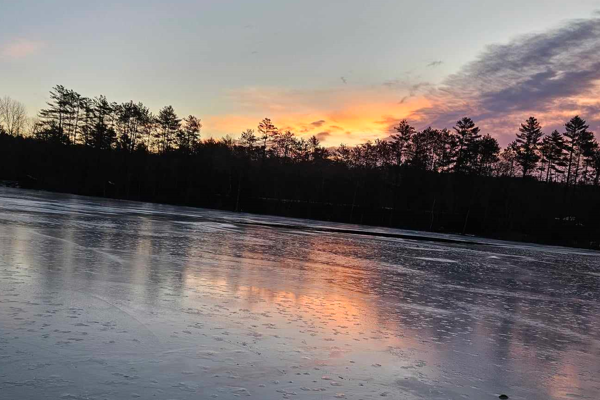
Thin-ice fishermen are out there, but warden urges extra care
By Julie Harris, Bangor Daily News Staff
Erik Johnson has been ice fishing for a month and a half already.
It’s not that he has secret spots with thick ice just waiting for discovery. No, it’s that he fishes on thin ice. He uses techniques he learned in a 10-hour safety course on saving yourself on thin ice the local fire department taught when he checks out a body of hopefully frozen water, he said.
But there is danger in early ice, and the Maine Warden Service is warning people to be careful on the state’s lakes and ponds. One fisherman has already died this season after going through the ice.
“We educate people about ice safety, but it’s really a personal decision of whether they go out on the ice,” said Lt. Aaron Cross of the Maine Warden Service’s Bangor office.
Avid ice fishermen like Johnson, 34, of Augusta say there are ways to be safe while pursuing their passion early in the season, including using safety gear when first going onto the ice.
Johnson, who described himself as a 230-pound man, has fished on an inch and a half of ice with open water not far away already this season. He fell through the ice once in another year and almost died, he said, but he still feels confident fishing on thin ice.
“I wouldn’t take any kids out on that. It would have to be at least 6 inches for them,” he said this week.
Sam Breton-Drew, 25, of Bridgton needs a minimum of 2 inches of ice, but he is concerned about the quality of it as much as the thickness, he said.
Ice safety is really specific to the lake or pond, and thickness is only one factor. Ice quality, the presence of inlets, outlets or natural springs, water depth and shadiness all play into what may be safe or unsafe, Cross said.
The Maine Department of Inland Fisheries and Wildlife recommends a minimum of 4 inches of good ice before walking on it. Good ice is defined as new, clear blue ice. White ice, which has snow in it, is only half as strong as good ice, according to the department’s website.
A rough guide the department provides on its ice safety page says it’s safe to walk on 4-6 inches of good ice; snowmobiles and ATVs can go on 5-7 inches; 8-12 inches supports cars or small trucks; and 12-15 inches should hold a medium-sized truck.
Ice color indicates quality, although even that may not be an absolute to judge safe ice, the department said.
Ice that is from light gray to dark black is weak and unsafe. Use caution with ice that is from white to opaque because it has snow in it and may be weak. Ice that is from blue to clear is the strongest and safest ice. Mottled or slushy ice, also referred to as “rotten ice,” is deteriorating from the bottom and may not be safe, the department said.
Small ponds that are protected from the wind will freeze and likely stay frozen, Cross said.
He recommends that people check ice conditions every time they venture out on even a familiar pond because ice can change overnight; let someone know where they are or go with a buddy; have a means of communication; and know the regulations for the lake or pond.
“It’s obviously a concern when people are fishing on thin ice,” Cross said. “Ice is inherently a dangerous thing.”
Breton-Drew checks the depth of ice using his chisel, stays close to shore and often sets his traps and then waits on shore until he has to tend a fishing trap, he said.
He sees value in using safety equipment and is working on accumulating some. The ice safety picks that you wear around your neck and can be used to help pull yourself out of the water and a new insulated flotation suit are on his wish list.
Johnson and his ice fishing buddy James Pontoo of Lewiston spent $150 on gas in three days recently trying to find a safe pond or lake to fish, Johnson said. They have been fishing in Kennebec and Franklin counties.
“People need to put in the work and learn about where they want to fish. They can’t just take someone’s word for it,” Johnson said. He can pull up a satellite map on his cell phone that shows the inlets, outlets and other features that might affect ice safety on ponds or lakes.
Johnson brings a chisel, rope, set of ice safety picks, a life jacket and has another person with him. He ties one end of the rope to the truck hitch and the other end around his waist. He wears the picks around his neck and dons his life jacket before he tests the ice with his chisel.
Johnson has already caught brook trout and brown trout this season. Breton-Drew has caught trout and bass.
“I live to ice fish,” Johnson said.